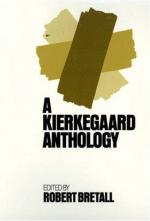
|
| Name: _________________________ | Period: ___________________ |
This test consists of 15 multiple choice questions and 5 short answer questions.
Multiple Choice Questions
1. What type of text does Kierkegaard routinely publish under his own name according to Robert Bretall in Chapter 10?
(a) Biblical.
(b) Political.
(c) Humoristic.
(d) Economical.
2. What does Hegel think truth is according to Chapter 8?
(a) Nothing.
(b) A whole.
(c) Christ's love.
(d) That men need to know Christ.
3. What does Robert Bretall in Chapter 10 say the pseudonymous work aims at?
(a) Tells people the truth without fear of retaliation.
(b) Captures Kierkegaard the man.
(c) Talks about the failures of Christianity.
(d) Convinces people to convert.
4. What does Kierkegaard believe the problem with modern Christianity is?
(a) It relies on dogma too much.
(b) It removes the possibility of offense despite how offensive it is.
(c) It is not in touch with reality.
(d) It is unforgiving.
5. How does Kierkegaard see the move towards equality as being?
(a) As regression.
(b) As progress.
(c) A mistake.
(d) An illusion.
6. What novel does Robert Bretall in Chapter 9 say Kierkegaard reviewed after the publication of Concluding Unscientific Postscript?
(a) Ages and faith.
(b) How to get faith.
(c) The two towers.
(d) The two ages.
7. What does Kierkegaard argue a Christian needs to be?
(a) A leader.
(b) A prophet.
(c) An Apostle.
(d) A follower.
8. What does Kierkegaard realize in "Rest at the foot of the altar"?
(a) He was wrong about Christ.
(b) Catholicism is better for the average man.
(c) That he teaches without authority.
(d) Regina did not love him.
9. Who did Kierkegaard receive communion from on his death bed?
(a) A priest.
(b) A bishop.
(c) Nobody.
(d) A layman.
10. Where does Kierkegaard argue truth is found?
(a) In Hegel's writings.
(b) In the relationship between the subject and his object.
(c) In Christ.
(d) Inside oneself.
11. When does Kierkegaard argue that action is only comprehensible?
(a) When faith guides our actions.
(b) When Christ is present.
(c) When there is possibility.
(d) When told to.
12. What does Kierkegaard argue is the heart of the public?
(a) The press.
(b) The law.
(c) Gambling.
(d) Faith.
13. What does Robert Bretall in Chapter 11 say about the views of Kierkegaard on Christianity the year before he dies?
(a) He will be disillusioned.
(b) He will reject Christ.
(c) He will convert to Catholicism.
(d) He will think that Christianity is stronger than ever.
14. Who does Bishop Mynster's eulogy compare him to?
(a) The apostles.
(b) Kierkegaard.
(c) Hegel.
(d) Christ.
15. What does The Sickness Unto Death argue is contained within man?
(a) Faith.
(b) Christ.
(c) The self.
(d) The infinite and the finite.
Short Answer Questions
1. What does Robert Bretall in Chapter 10 say Kierkegaard's work written under his own name aims at?
2. What does Kierkegaard focus on in Two Discourses?
3. When is Concluding Unscientific Postscript published?
4. What does Kierkegaard argue Christendom is ruled by?
5. What does Robert Bretall in Chapter 11 say Kierkegaard rejects and critiques?
|
This section contains 453 words (approx. 2 pages at 300 words per page) |

|




